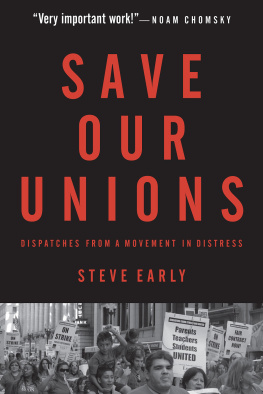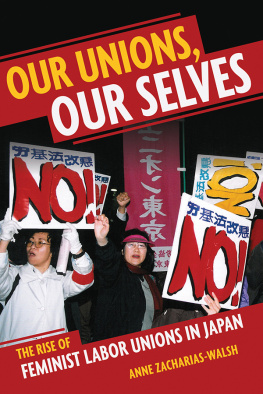THE ANTHROPOLOGY OF
LABOR UNIONS
THE ANTHROPOLOGY OF
LABOR
UNIONS
EDITED BY E. Paul Durrenberger and Karaleah S. Reichart
UNIVERSITY PRESS OF COLORADO
2010 by the University Press of Colorado
Published by the University Press of Colorado
5589 Arapahoe Avenue, Suite 206C
Boulder, Colorado 80303
All rights reserved
Printed in the United States of America

| The University Press of Colorado is a proud member of the Association of American University Presses. |
The University Press of Colorado is a cooperative publishing enterprise supported, in part, by Adams State College, Colorado State University, Fort Lewis College, Mesa State College, Metropolitan State College of Denver, University of Colorado, University of Northern Colorado, and Western State College of Colorado.
 The paper used in this publication meets the minimum requirements of the American National Standard for Information SciencesPermanence of Paper for Printed Library Materials. ANSI Z39.48-1992
The paper used in this publication meets the minimum requirements of the American National Standard for Information SciencesPermanence of Paper for Printed Library Materials. ANSI Z39.48-1992
Library of Congress Cataloging-in-Publication Data
The anthropology of labor unions / E. Paul Durrenberger and Karaleah S. Reichart, editors.
p. cm.
Includes bibliographical references and index.
ISBN 978-0-87081-965-0 (hardcover : alk. paper) 1. Labor unionsHistory. 2. Labor
unionsPolitical activityHistory. 3. Labor unionsUnited StatesHistory. I.
Durrenberger, E. Paul, 1943 II. Reichart, Karaleah S.
HD6451.A58 2010
331.880973dc22
2009047987
Design by Daniel Pratt
18 17 16 15 14 13 12 11 10 09 10 9 8 7 6 5 4 3 2 1
THE ANTHROPOLOGY OF
LABOR UNIONS
ONE
Introduction
E. Paul Durrenberger and Karaleah Reichart
The Anthropology of Labor Unions in a Global Political Economy
This collection is a move toward a definition of an anthropology of unions. Questions about unions can only arise in complex social orders with class structures that define incompatible interests between owners of capital and workers. Unions only come into existence when those with privileged access to resources hire others to create value the owners can appropriate for their own use. When those without privileged access to resources organize to identify, promote, and protect their interests, labor unions are born.
Most studies of unions are developed from historical perspectives or are based on national data sets collected by government agencies. Few use the defining method of socio-cultural anthropology: ethnography, which has much to teach us about the nature of unions. The studies in this book bring ethnographic methods to bear on unions. Anthropology is also comparative. The authors in this volume situate their individual ethnographies within a broader comparative framework that tells us what the ethnography of unions can contribute to a broader anthropology of contemporary states.
While most of the works in this collection address labor unions inside the United States and look outward from that perspective toward its global supply and production lines, the picture would look quite different through a view from the South (such as Zlolniski sketches), from Africa (as Otaez develops), or from Europe. In Northern Europe, for instance, jobs are more stable than they are in the United States; although structural unemployment is high in countries such as Germany, the state is more supportive of working-class organizations than the North American state has ever been. We cannot go into the details of such a comparison here, but we hope to lay the groundwork for comparative studies of unions within a larger global framework.
The postindustrial United States is the site of six of the books eight studies, inviting regional comparisons as well as suggesting national trends. The other two chapters describe working life among people in two countries that provide some of the lowest wages in the global labor market: Mexico and Malawi. The globalization of manufacturing as well as agricultural products such as vegetables from Mexico and tobacco from Malawi is a component of a larger global process of integration promoted by the Bretton Woods agreements that were intended to provide stability after World War II. These international agreements have resulted in the normalization of neo-liberal economic policies of free trade and a race to reduce labor costs by exporting manufacturing and production of raw materials. These processes have resulted in the exportation of manufacturing jobs to low-wage markets and the immigration of people from low-wage lands to Europe and North America. Both processes pose challenges for the American labor movement.
Ethnography is local, so each study in this book discusses a local response to these issues of globalization. Although we do not explicitly develop them, regional comparisons within the United States could develop the themes the local ethnographies discussfor instance, the place of rugged individualism and the American myth in the right-to-work states of the West that Smith discusses in her ethnographic treatment of miners in Wyoming versus eastern states with longer traditions of unionism such as Reichart discusses in her ethnography of West Virginia miners. The question of regional differences in the role of religion in U.S. politics and culture comes to the fore in Smith-Noninis treatment of farmworkers in North Carolina. Likewise, the comparison of agricultural workers in North Carolina with those on the California border arises from Zlolniskis description of agricultural production in Baja California. The mutual dependency of transnational corporations and state-sponsored unions that Otaez and Zlolniski discuss illustrates the power of global political and economic forces when national elites give them free reign to keep their citizens living and working in serf-like conditions. Matters of place are the central focus of Savages discussion of how a union is but one dimension of the complex lives of its members. Zlolniski points to similar gender issues of the timing of agricultural and domestic work that Savage discusses in connection with healthcare work and domestic duties.
In addition to the insight these studies provide into processes of globalization, they offer a privileged window through which to study the processes of class as they unfold over time and across space. Unions are perforce a phenomenon of class. The study of unions therefore helps elucidate the operation of classes in stratified social orders.
Collective Action
Unions are a form of collective action to achieve shared goals. These chapters focus on unions as such rather than on collective action. The topic of collective action is important in anthropology because it has played such a large role in both our biological and our cultural evolution (). Several questions resonate through the studies in this volume, including:
What happens to unions that are denied a collective goal? How can they organize members for collective action when collective action is not available to them?
How do organizations pursue collective goals in the face of strong opposition?
How do members whose individual interests are not being directly served but who are financing collective action conceive of such collective action, and to what extent should they support it to achieve longer-term, more abstract goals?
All these questions are important from the standpoint of theory as well as practice. Anthropologists agree that culture is collective, although they may question what groups of people share it, as Ulf Hannerz () does. But there is quite a leap from collective thought to collective action.
Next page








 The paper used in this publication meets the minimum requirements of the American National Standard for Information SciencesPermanence of Paper for Printed Library Materials. ANSI Z39.48-1992
The paper used in this publication meets the minimum requirements of the American National Standard for Information SciencesPermanence of Paper for Printed Library Materials. ANSI Z39.48-1992